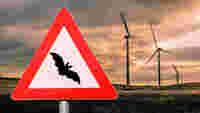In this area of tension, WAGO controllers offer a way out: Instead of always putting wind turbines in idle mode under certain conditions in general, a programmable logic controller (PLC) from WAGO helps to adapt the switch-off times to every individual site, optimizing them.
The reasons for having an external controller handle this are quite practical. “The statutory developments are very dynamic; and the requirements are constantly changing and also differ by federal state,” explains Jochen Poitzsch. The alternative would have been updating the SCADA controllers of the wind turbines for every change to the requirements – too time-consuming, Senvion decided.
Therefore, the solution that has been developed now works as follows: “The decision to switch off is not made on the basis of costly sensors that detect the actual presence of bats,” explains WAGO engineer Nino Flottmann. Instead, it is based on a flexible algorithm that takes numerous scientifically determined factors into account such as sunrise and sunset, temperature, wind speed, and precipitation among other things. The scientific factors trace back to the WINDBAT research initiative, which investigates the risk of bat collisions with onshore wind turbines. As part of its investigations, this research group also developed the “ProBat” software tool, which can be used to calculate bat-friendly operating algorithms for wind turbines. This tool also forms the basis for the solution used at Senvion.
“We then apply local weather data directly from the SCADA system of the wind turbine,” adds Flottmann. That is no problem, thanks to the open interfaces of the WAGO PLC. Nino Flottmann parameterized all the other data through the Web interface. If all the switch-off conditions are met, the SCADA system of the wind turbine receives the stop command from the WAGO controller, and the rotors quickly come to a standstill.
All switch-offs, including the current states of the system, are stored in a file and sent to the plant operator monthly. The system status can be queried at any time through the Simple Network Management Protocol (SNMP). If the legal requirements change, the operator can bring the controllers up-to-date without significant time and effort: The operator changes the default values in the algorithm accordingly and stores the file on an SD card or online. As soon as this data has been loaded onto the WAGO controller, the new values are applied automatically.

